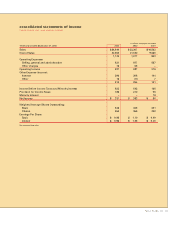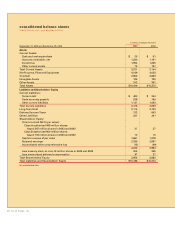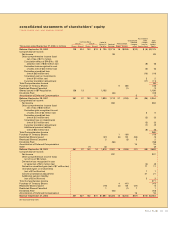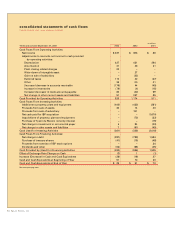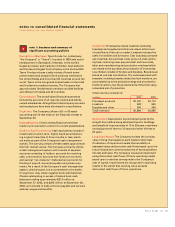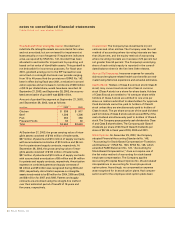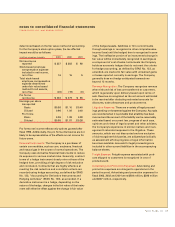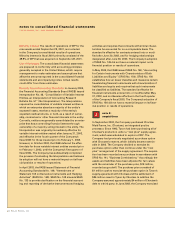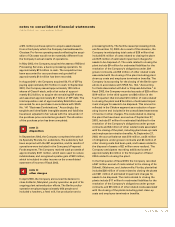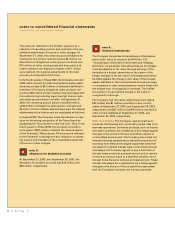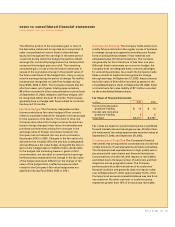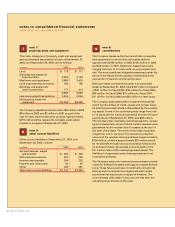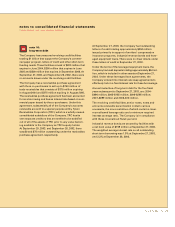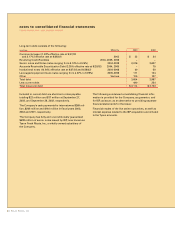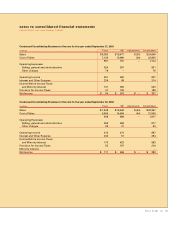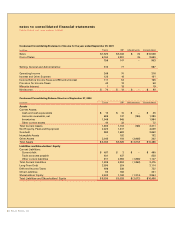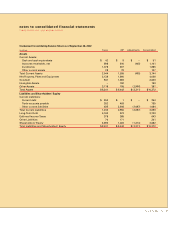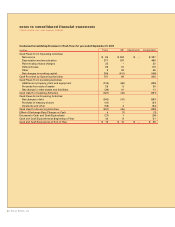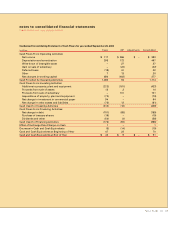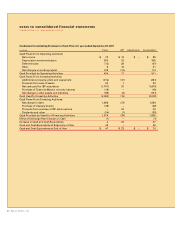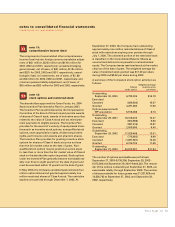Tyson Foods 2003 Annual Report Download - page 43
Download and view the complete annual report
Please find page 43 of the 2003 Tyson Foods annual report below. You can navigate through the pages in the report by either clicking on the pages listed below, or by using the keyword search tool below to find specific information within the annual report.
Tyson Foods, Inc. 41
notes to consolidated financial statements
TYSON FOODS, INC. 2003 ANNUAL REPORT
The effective portion of the cumulative gain or loss on
the derivative instrument is reported as a component of
other comprehensive income (loss) in shareholders’
equity and recognized into earnings in the same period
or periods during which the hedged transaction affects
earnings (for commodity hedges when the chickens that
consumed the hedged grain are sold). The remaining
cumulative gain or loss on the derivative instrument in
excess of the cumulative change in the present value of
the future cash flows of the hedged item, if any, is recog-
nized in earnings during the period of change. No ineffec-
tiveness was recognized on cash flow hedges during
fiscal 2003, 2002 or 2001. The Company expects that the
after tax losses, net of gains, totaling approximately
$6 million recorded in other comprehensive income (loss)
at September 27, 2003, related to cash flow hedges, will
be recognized within the next 12 months. The Company
generally does not hedge cash flows related to commodi-
ties beyond 12 months.
Fair Value Hedges: The Company designates certain
futures contracts as fair value hedges of firm commit-
ments to purchase livestock for slaughter and natural gas
for the operation of its plants. From time to time, the
Company also enters into foreign currency forward con-
tracts to hedge changes in fair value of receivables and
purchase commitments arising from changes in the
exchange rates of foreign currencies; however, the
Company has not entered into any such contracts in
fiscal years 2003 or 2002. Changes in the fair value of a
derivative that is highly effective and that is designated
and qualifies as a fair value hedge, along with the loss or
gain on the hedged asset or liability that is attributable
to the hedged risk (including losses or gains on firm
commitments), are recorded in current period earnings.
Ineffectiveness results when the change in the fair value
of the hedge instrument differs from the change in fair
value of the hedged item. Ineffectiveness recorded
related to the Company’s fair value hedges was not
significant during fiscal 2003, 2002 or 2001.
Undesignated Positions: The Company holds certain com-
modity futures contracts in the regular course of business
to manage its exposure against commodity price fluctua-
tions on anticipated purchases of raw materials and
anticipated sales of finished inventories. The contracts
are generally for short durations of less than one year.
Although these instruments are economic hedges, the
Company does not designate these contracts as hedges
for accounting purposes. As a result, the Company marks
these contracts to market and recognizes the change
through earnings. At September 27, 2003, these contracts
had a fair value of $14 million recorded as assets on the
consolidated balance sheet. At September 28, 2002, these
contracts had a fair value liability of $11 million recorded
on the consolidated balance sheet.
Fair Values of Financial Instruments:
in millions 2003 2002
Commodity derivative
positions–liability $ 13 $ 12
Interest-rate derivative
positions–liability 4 6
Total debt $ 4,011 $ 4,397
Fair values are based on quoted market prices or published
forward interest rate and natural gas curves. All other finan-
cial instruments’ fair values approximate recorded values at
September 27, 2003, and September 28, 2002.
Concentrations of Credit Risk: The Company’s financial
instruments that are exposed to concentrations of credit risk
consist primarily of cash equivalents and trade receivables.
The Company’s cash equivalents are in high quality securi-
ties placed with major banks and financial institutions.
Concentrations of credit risk with respect to receivables
are limited due to the large number of customers and their
dispersion across geographic areas. The Company
performs periodic credit evaluations of its customers’
financial condition and generally does not require collat-
eral. At September 27, 2003, approximately 10.3% of the
Company’s net accounts receivable balance was due from
one customer. No other customer or customer group
represents greater than 10% of net accounts receivable.


